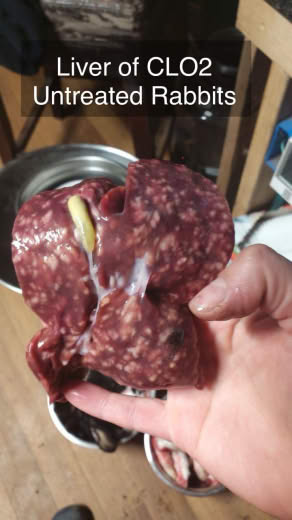Liver coccidiosis in Rabbits
Case Report:

Successful Treatment of Coccidiosis in Rabbits Using Chlorine Dioxide and DMSO

Background
Coccidiosis, caused by protozoan parasites of the genus Eimeria, is a common concern in rabbit husbandry, particularly affecting the liver. The traditional view holds that coccidiosis can be challenging to treat, often leading to recommendations for extreme measures such as depopulation of infected stock.
Case Description
This report details the case of a breeding operation focused on American heritage, pedigree Silver Fox rabbits. All young meat rabbits of similar age exhibited signs of hepatic coccidiosis, evident through clinical observation and post-mortem findings.
Treatment Protocol
In an attempt to address this condition, one rabbit was selected for treatment as a test subject. The treatment commenced on September 24th and involved administering a solution consisting of 3 drops of chlorine dioxide (ClO2) combined with dimethyl sulfoxide (DMSO) in the rabbit's drinking water.
Outcome
The treated rabbit was evaluated regularly throughout the treatment period. Following approximately 56 days of treatment, the rabbit was processed for meat on November 18th. A thorough examination of the liver revealed no signs of coccidial infection, indicating a successful outcome.
Discussion
This case challenges the prevailing belief that coccidiosis is incurable without conventional pharmaceuticals. The use of chlorine dioxide and DMSO appears to have effectively eradicated the infection in this instance. Further investigation into the efficacy and safety of this treatment protocol is warranted to determine its applicability across broader populations.
Conclusion
This report suggests that alternative treatment options may exist for managing coccidiosis in rabbits. Continued research and clinical observation are necessary to substantiate these findings and potentially offer new avenues for treating this common parasitic infection in veterinary practice.
For further discussion and insights, join the conversation here.
